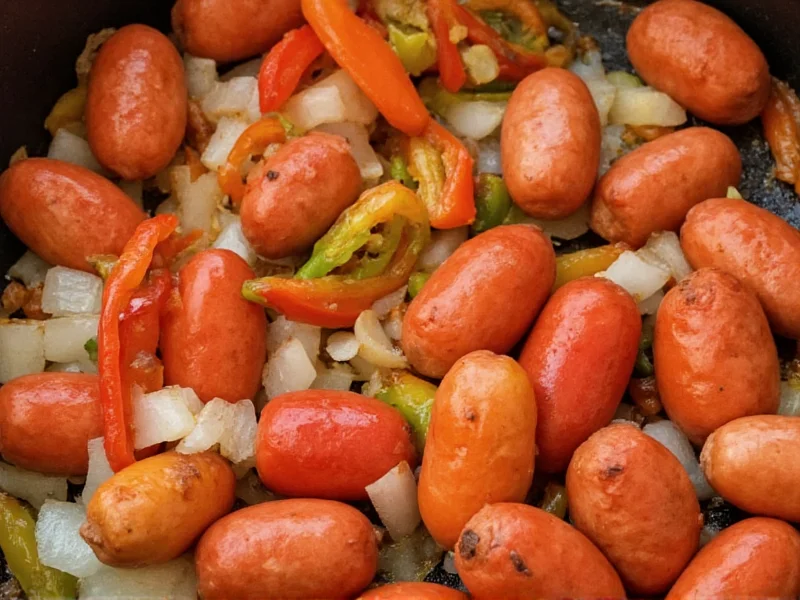The Essential Guide to Perfect Sausage Peppers and Onions
Sausage peppers and onions represents one of America's most beloved comfort food combinations. This simple yet flavorful dish has become a staple at family gatherings, sporting events, and neighborhood restaurants across the country. Understanding how to prepare this dish properly transforms basic ingredients into a meal that satisfies with minimal effort.
Why This Dish Works So Well
The magic of sausage peppers and onions lies in the perfect balance of flavors and textures. The natural sweetness of bell peppers and onions caramelizes beautifully when cooked, complementing the savory, slightly spicy notes of quality Italian sausage. When prepared correctly, the vegetables maintain some texture while absorbing the sausage's rich flavors, creating a harmonious blend that works equally well as a main course or sandwich filling.
Choosing Your Ingredients Wisely
Selecting the right components makes all the difference in your sausage peppers and onions recipe. For authentic results, consider these recommendations:
| Ingredient | Recommended Type | Why It Matters |
|---|---|---|
| Sausage | Sweet Italian sausage (mild) | Provides traditional flavor without overwhelming heat |
| Peppers | Mixed bell peppers (red, yellow, green) | Different colors offer varying sweetness levels and visual appeal |
| Onions | Yellow onions | Caramelize beautifully and provide depth of flavor |
| Cooking Fat | Olive oil | Enhances flavor while preventing sticking |
Step-by-Step Cooking Instructions
Follow these straightforward steps for restaurant-quality sausage peppers and onions every time:
- Prepare ingredients: Slice 3 bell peppers (1 of each color) into 1/4-inch strips. Cut 2 medium yellow onions similarly. Remove sausage from casings if using links.
- Start with the sausage: Heat 2 tablespoons olive oil in a large skillet over medium-high heat. Add 1.5 pounds sweet Italian sausage and cook until browned (about 5-7 minutes), breaking into chunks.
- Cook vegetables: Remove sausage, leaving drippings. Add peppers and onions with 1/2 teaspoon salt. Cook 15-18 minutes until tender-crisp, stirring occasionally.
- Combine and finish: Return sausage to skillet. Add 2 minced garlic cloves and 1/4 cup chicken broth. Cook 3-4 minutes until heated through and flavors meld.
- Season to perfection: Adjust with black pepper, red pepper flakes, or fresh herbs as desired before serving.
Avoiding Common Mistakes
Many home cooks encounter issues with their sausage peppers and onions preparation. Understanding these pitfalls ensures better results:
- Overcrowding the pan: Cook in batches if necessary to prevent steaming instead of sautéing
- Incorrect heat level: Medium-high provides proper caramelization without burning
- Adding salt too early: Salt draws out moisture, delaying caramelization—add after vegetables hit the pan
- Underseasoning: This dish needs proper seasoning to balance the natural sweetness
Variations to Explore
While traditional sausage peppers and onions remains popular, these adaptations offer exciting alternatives:
- Spicy version: Use hot Italian sausage and add red pepper flakes during cooking
- Healthy adaptation: Substitute turkey sausage and reduce oil with broth for sautéing
- Grilled option: Cook everything on a sheet pan over medium grill heat for smoky flavor
- Wine-enhanced: Deglaze pan with 1/4 cup dry white wine before adding garlic
Serving Suggestions and Pairings
Sausage peppers and onions shines in multiple serving styles. Consider these presentation ideas for your next meal:
- Serve over creamy polenta for a comforting dinner
- Fill crusty hoagie rolls for authentic Italian sandwiches
- Pair with roasted potatoes for a complete meal
- Top with fresh basil and Parmesan cheese before serving
- Accompany with a simple arugula salad for contrast
Storage and Reheating Tips
This dish often tastes even better the next day as flavors continue to meld. For best results:
- Cool completely before storing in airtight containers
- Refrigerate for up to 4 days or freeze for 3 months
- Reheat gently in a skillet with a splash of broth to maintain moisture
- Avoid microwaving which can make vegetables mushy
- Add fresh herbs after reheating for brightness
Frequently Asked Questions
What's the best sausage for peppers and onions?
Sweet Italian sausage provides the traditional flavor profile that works perfectly with peppers and onions. Look for quality sausage with visible meat texture and minimal fillers. Mild Italian sausage offers the classic taste without excessive heat, though hot Italian sausage works well for those who prefer spicier dishes.
How long does it take to cook sausage peppers and onions properly?
The entire cooking process takes approximately 25-30 minutes. Sausage needs 5-7 minutes to brown properly, while the peppers and onions require 15-18 minutes to reach the ideal tender-crisp texture with proper caramelization. Rushing the vegetable cooking stage results in underdeveloped flavors and less appealing texture.
Can I make sausage peppers and onions ahead of time?
Yes, sausage peppers and onions actually improves when made ahead. Prepare the dish completely, cool, and store in the refrigerator for up to 4 days. The flavors continue to meld during storage. When reheating, add a small amount of broth or water to restore moisture, and finish with fresh herbs for brightness. This makes it an excellent meal prep option.
What are traditional serving methods for sausage peppers and onions?
The most traditional serving method is in a crusty hoagie roll as an Italian sausage sandwich. Many restaurants serve it over pasta or polenta as a complete meal. Home cooks often present it as a side dish alongside roasted potatoes or serve it simply on a plate with crusty bread for dipping. In Philadelphia, it's commonly served as a topping for cheesesteaks in certain variations.
How can I prevent my peppers and onions from becoming mushy?
To maintain proper texture, slice vegetables uniformly to 1/4-inch thickness, avoid overcrowding the pan, and cook over medium-high heat. Don't cover the skillet during cooking, as this traps steam. The vegetables should sizzle when they hit the pan. Properly cooked peppers and onions should be tender but still offer slight resistance when bitten, not soft or watery.











 浙公网安备
33010002000092号
浙公网安备
33010002000092号 浙B2-20120091-4
浙B2-20120091-4